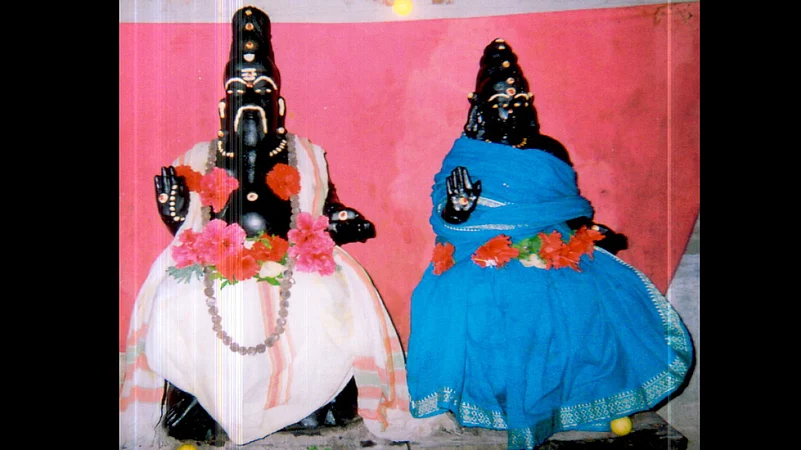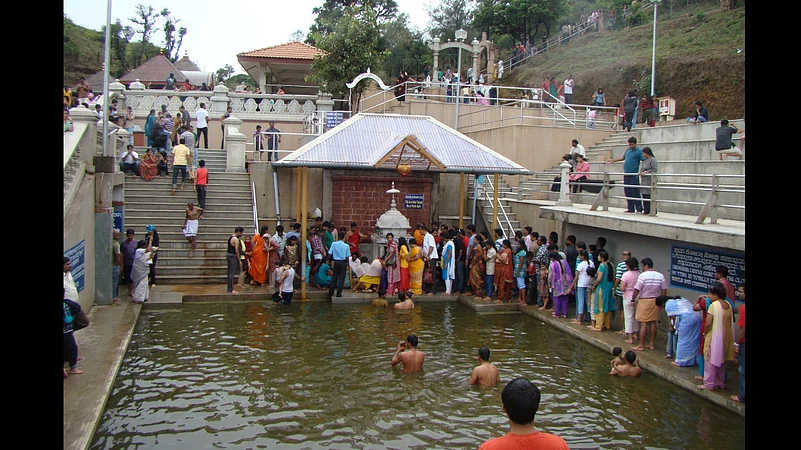The Kaveri (earlier known as Ponni, the golden maid, because of the fine golden silt deposits) flows through Karnataka and Tamil Nadu. The river originates at Talakaveri in the Brahmagiri Range in the Western Ghats, of Karnataka’s Kodagu district,1,341 m above sea level, and flows in a south-easterly direction for about 800 km before emptying into the Bay of Bengal. It reaches the sea in Poompuhar in Mayiladuthurai district. This is Tamil Nadu’s largest river, dividing the state into north and south.
The Kaveri is a sacred river and is worshipped as the goddess Kaveramma. Its name comes from the Sankethi word for river.
Advertisement
Myths and legends
The story of how Kaveri came to be begins with how the sage Agastya came south. A mountain called Vindhya had an inflated opinion of itself. However, when a person praised Meru, another mountain, right in front of Vindhya, Vindhya grew jealous. Wanting to be taller than Meru, it started growing skywards.
Soon, Vindhya would block the sun. The people, animals, and trees in the forests lying in Vindhya’s shadow stopped receiving any sunlight. No matter how high the sun rose, Vindhya grew taller and blocked his light. The pleas of the people, animals, and the forests fell on deaf ears.
Advertisement
As a last resort, the gods approached the powerful sage Agastya for help. On reaching Vindhya, the sage asked him to bend so that he could cross over to the south. Since Agastya was known for his wrath, Vindhya did not want to be cursed and agreed to bend. After Agastya had crossed over, he asked Vindhya to stay that way till he returned. Vindhya promised to do so. The sage wisely stayed back in the south, leading to much happiness among the people around the Vindhya.
With his yogic powers, Agastya collected the most beautiful parts of creatures in the forests he visited and put them together in the form of a beautiful infant. He now wanted someone to raise the child and decided to marry.
Meanwhile, king Kavera, who ruled in that region, had also prayed to Lord Brahma for a child. In a mythologically convenient coincidence, Lord Brahma had a daughter Vishnumaya, who craved to serve humanity.
Brahma blessed Kavera so that Vishnumaya was born to him as Lopamudra. In yet another coincidence, she was also the infant Agasthya created. Lopamudra became a beautiful woman, with her craving to serve humanity intact.

On one of his many travels, Agastya met Lopamudra, and asked Kavera for her hand in marriage. He was already of advanced age, had gnarled looks, wore the clothes of a mendicant and his unkempt hair stood out. Yet, Lopamudra agreed to marry the sage on one condition—he was not to leave her alone for a great stretch of time. If he did, she would leave. Sage Agasthya agreed.
Advertisement
After the marriage, this unlikely couple settled down in sage Agastya’s ashram. Once, on his travels, the sage fell ill and fainted. Since no help was in sight, Lopamudra had to carry him home by herself. Somehow, the strong-willed Lopamudra began carrying him home. On the dark path home, Agastya’s dangling foot touched a sleeping holy man. Absolutely furious, the holy man cursed the owner of the foot that he would die at sunrise.
Lopamudra, however, thought that this was unfair. After all, she was the one carrying the sage and had not meant to humiliate the holy man deliberately. So, to prevent the curse from taking effect, she invoked: “May the sun not rise if I have been a good and chaste wife and helped my husband.”
Advertisement
The sun really did not rise and the earth was enveloped in darkness. Shaken, the gods came running to Lopamudra begging her to lift her ban on the sunrise. Explaining her reason, she offered to lift the ban only if they lifted the uncalled-for curse by the holy man. The gods did as told—sage Agastya lived and Lopamudra lifted her ban. The sun rose and all was well again on Earth.
Legend explains how Lopamudra became Kaveri. The people in the present-day Kaveri basin region were facing intense drought and crop loss. They prayed to Lord Ganesha, the remover of obstacles, for help.
Advertisement
Since Agastya would not part from Lopamudra, he turned her into water and left her in the kamandala he carried with him. Seeing an opportunity, Lord Ganesha took the form of a crow and toppled the kamandala leading Lopamudra to flow out as a river. The sage’s disciples tried to stop her, but she felt this was her way of serving people. Diving into the Earth, she reappeared at Bhagamandala. Much later, Agastya came looking for her and recognised her in the river she had become. This river came to be called Kaveri, as she was Kavera’s daughter.
Wanting to be the holiest river, she prayed to Lord Vishnu asking to be made holier than the Ganga. Vishnu explained that Ganga’s holiness could not be undermined as she originated from his feet. He offered Kaveri to be his garland, close to his heart—and therefore, more sacred. And that is how three of the holiest shrines of Vishnu—the Adi Ranga, the Madhya Ranga and the Antya Ranga—came to be at Srirangapatna, Shivanasamudra and Srirangam respectively. In each of these places, the temples are on islands with the Kaveri encircling it—just like the mythical garland.
Advertisement
From this legend comes another which says that the river Ganga herself comes, via an underground route, to bathe in the Cauvery and cleanse herself every year. Just as Vishnumaya had wanted, she flowed on Earth as Kaveri serving humanity.
Where to go
Located in the Brahmagiri Hills in Karnataka’s Coorg district, Talakaveri is generally considered to be the source of the Kaveri. A tank and a temple (in honour of the goddess Kaveramma) have been built at the spot the river is said to originate. The river itself feeds off a spring close to the tank. In normal times, thousands of Hindu devotees visit Talakaveri at the time of the Kaveri Sankramana, a festival that celebrates the annual emergence of the river. Talakaveri also offers excellent panoramic views of the surrounding Western Ghats.
Advertisement

Then, there are the three river-island towns Srirangapatna—(in Karnataka), Shivanasamudra (in Karnataka) and Srirangam (in Tamil Nadu). These places house three of the holiest shrines, each dedicated to Ranganatha, an avatar of Lord Vishnu—the Adi Ranga, the Madhya Ranga and the Anthya Ranga, respectively. In each of these locations, mythology meets reality as Kaveri encircles these islands in the shape of a mythical garland.
Festival to attend
The aforementioned Kaveri Sankramana is perhaps the holiest festival associated with the river, celebrated usually in mid-October in Talakaveri every year. Another important festival is the Kaveri Pushkaram, observed once every 12 years in Mayiladuthurai in Tamil Nadu. It is marked by a ritualistic dip in the Kaveri’s waters and elaborate pujas on the Thula Ghat.
Advertisement

Two other festivals in honour of the Kaveri are Aadi Perukku and Kaveri Vellam. Aadi Perukku sees women worship nature and goddess Parvati by making rice and flower offerings. They also take a dip in the Kaveri at the several bathing ghats along the course of the river. Kaveri Vellam, on the other hand, is one of those rare festivals that celebrates floods. In the 12 districts that the Kaveri passes through in Tamil Nadu, people offer aartis in the flooded, overflowing river before moving to higher ground and safety. The belief is that the river will not harm the devout people and instead bless them with bountiful harvests.




















